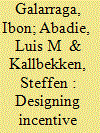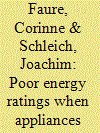|
|
|
Sort Order |
|
|
|
Items / Page
|
|
|
|
|
|
|
| Srl | Item |
| 1 |
ID:
113415


|
|
|
|
|
| Publication |
2012.
|
| Summary/Abstract |
This paper presents an analysis of the cost-effectiveness of high-efficiency appliances in the U.S. residential sector using cost and efficiency data developed as part of the regulatory process of the U.S. Department of Energy's Appliances and Commercial Equipment Standards Program. These data are presented as a case study in the development of an 'efficiency technology database' which can be expanded and published as a resource to other researchers and policy makers seeking scenarios that optimize efficiency policies and forecast their likely impacts on energy demand and greenhouse gas emissions. The use of this data to evaluate cost-effectiveness according to a variety of metrics is demonstrated using the example of one refrigerator-freezer product class. Cost-effectiveness is then evaluated in terms of cost of conserved energy for refrigerators, room air conditioners, water heaters, cooking equipment, central air conditioners and gas furnaces. The resulting potential of cost-effective improvement ranges from 1% to 53% of energy savings, with a typical potential of 15-20%.
|
|
|
|
|
|
|
|
|
|
|
|
|
|
|
|
| 2 |
ID:
150823


|
|
|
|
|
| Summary/Abstract |
The energy-efficiency gap has been high on research and policy agendas for several decades. Incentive schemes such as subsidies, taxes and bonus-malus schemes are widely used to promote energy-efficient appliances. Most research, however, considers instruments in isolation, and only rarely in the context of political constraints on instrument use, or for alternative policy goals. This paper presents a methodology for the optimal design of incentive schemes based on the minimisation of Dead Weight Loss for different policy goals and policy restrictions. The use of the methodology is illustrated by designing optimal combinations of taxes and subsidies in Spain for three types of appliance: dishwashers, refrigerators and washing machines. The optimal policies are designed subject to different policy goals such as achieving a fixed reduction in emissions or a certain increased market share for efficient appliances, and for policy constraints such as budget neutrality. The methodology developed here can also be used to evaluate past and current incentive schemes.
|
|
|
|
|
|
|
|
|
|
|
|
|
|
|
|
| 3 |
ID:
111370


|
|
|
|
|
| Publication |
2012.
|
| Summary/Abstract |
This paper discusses domestic energy use and energy behaviour. It shows some improvement in domestic energy consumption and adoption of good energy practice. The survey conducted indicated that 35% of homes could improve their energy efficiency by improved tank insulation. In the last 5 years condensing boilers have been installed only in 3% of homes, indicating that householders are unaware of their advantages. Although 88% of surveyed homes had purchased a major appliance in the last 2 years, only 16% had any idea of the energy rating of their new appliances. Use of energy saving light bulbs is predominant in kitchens compared to other rooms. 70-80% of householders undertook some kind of day-to-day energy efficiency measures. 20-35% of householders would like to invest in energy-saving measures but found cost to be a key barrier. Approximately 84% of those surveyed were unaware of the energy rating of their household appliances. Price and brand were the most important factors determining the purchase of a new appliance. Significant energy-saving could be achieved by providing appropriate information to the general public regarding temperature control, efficiency of appliances and energy-saving heating systems.
|
|
|
|
|
|
|
|
|
|
|
|
|
|
|
|
| 4 |
ID:
176652


|
|
|
|
|
| Summary/Abstract |
To date, research has mostly focused on the impact of energy efficiency on the total electricity demand but not on the electricity demand profiles. To address this gap, we estimate the impact of energy efficiency measures and policies such as minimum energy performance standards on the peak load by developing a bottom-up model that generates Swiss household hourly electricity demand profiles per appliance based on time use data. The model estimates that evening appliance peak demand can be reduced by 38% when the appliances are replaced by the highest energy efficiency label available on market. We find that changing light bulbs to LED would have the same peak reduction as switching cooking or wet appliances to off-peak periods throughout the year. We also show that the evening appliance peak demand could reduce in 2035 by 24% thanks to the improvement of the energy performance of the stock. Cooking appliances, the least favourable appliances to be involved in demand response, is expected to be the highest contributors to the evening peak in 2035. Our findings show that policy makers should pay due attention to energy efficiency improvement not only for reducing electricity demand but also in order to reduce peak load.
|
|
|
|
|
|
|
|
|
|
|
|
|
|
|
|
| 5 |
ID:
179667


|
|
|
|
|
| Summary/Abstract |
The European Union has decided to replace its previously existing A+++ to D labelling scheme for cold appliances with a rescaled A to G labelling scheme in 2021. Employing a demographically representative discrete choice experiment on refrigerator adoption using an online survey among more than 1000 households in Germany, this paper explores the effects of the rescaled scheme compared to the previous scheme on the stated uptake of top-rated refrigerators, i.e. those classified A+++ under the previous scheme and B under the rescaled scheme. Since in practice both schemes may be shown for a transitory period, the paper also explores the effects of displaying both labels simultaneously. The findings from estimating a mixed logit model suggest that showing the rescaled label alone significantly increases valuation of top-rated refrigerators compared to showing the previous A+++ to D label alone. In comparison, when the previous A+++ to D and the rescaled A to G schemes are shown simultaneously, no benefits of introducing the rescaled label are found. Thus, policymakers should strive to enforce the application of the rescaled labelling scheme as quickly as possible and to shorten transitory periods where both labels are shown simultaneously.
|
|
|
|
|
|
|
|
|
|
|
|
|
|
|
|
| 6 |
ID:
110426


|
|
|
|
|
| Publication |
2011.
|
| Summary/Abstract |
This study seeks to the following: (1) understand the factors/characteristics typically considered when purchasing electrical appliances, (2) analyse the differences between consumer profiles regarding these and (3) understand the factors driving the consideration of energy efficiency class by purchasers. Results indicate a preference for first considering cost, followed by quality and energy consumption considerations. These are correlated positively with the consideration of energy efficiency class in consumer choices. Also, regression analysis shows environmental attitudes to be negative predictors of energy efficiency class consideration, while specific environmental behaviours were positive predictors. Finally, consumer profiles were identified based on gender, age and whether or not the purchaser was accompanied when decisions were made. Implications for retail employee training and the development of persuasive messages for consumers based on established profiles are discussed.
|
|
|
|
|
|
|
|
|
|
|
|
|
|
|
|
| 7 |
ID:
113450


|
|
|
|
|
| Publication |
2012.
|
| Summary/Abstract |
In the development of effective product efficiency policy, the critical element for policy makers is comprehensive, independent information. However, easily accessible, reliable information on the energy performance of products and policies is often scarce within a particular market, and rarer still if the policy maker is seeking comparisons on an international level. This article presents a method (Mapping & Benchmarking) to compare energy efficiency of products across countries, and the results for 3 products: refrigerators-freezers, washing machines and laundry driers. The results show an improvement of the efficiency over time for these products. However, part of this improvement is due to increased capacity of the products and not to lower energy consumption. Therefore policy makers should consider the development of policies based on product energy consumption and not (only) on product efficiency in order to capture the full potential of technology improvements for energy savings. Results for refrigerator-freezers suggest that in the long run both a policy strategy where minimum efficiency requirements are prominent and a policy strategy where a mandatory energy label is prominent can provide for increasing efficiencies.
|
|
|
|
|
|
|
|
|
|
|
|
|
|
|
|
| 8 |
ID:
125400


|
|
|
|
|
| Publication |
2013.
|
| Summary/Abstract |
We applied conditional demand analysis (CDA) to estimate the average annual energy use of various electrical and natural gas appliances, and derived energy reductions associated with certain appliance upgrades and behaviours. The raw data came from 9773 Canadian households, and comprised annual electricity and natural gas use, and responses to >600 questions on dwelling and occupant characteristics, appliances, heating and cooling equipment, and associated behaviours. Replacing an old (>10 years) refrigerator with a new one was estimated to save 100 kW h/year; replacing an incandescent lamp with a CFL/LED lamp was estimated to save 20 kW h/year; and upgrading an old central heating system with a new one was estimated to save 2000 kW h/year. This latter effect was similar to that of reducing the number of walls exposed to the outside. Reducing the winter thermostat setpoint during occupied, waking hours was estimated to lower annual energy use by 200 kW h/°C-reduction, and lowering the thermostat setting overnight in winter relative to the setting during waking hours (night-time setback) was estimated to have a similar effect. This information may be used by policy-makers to optimize incentive programs, information campaigns, or other energy use change instruments.
|
|
|
|
|
|
|
|
|
|
|
|
|
|
|
|
| 9 |
ID:
176658


|
|
|
|
|
| Summary/Abstract |
Conveyance, i.e., leaving one's appliance in the dwelling when moving out, shortens the expected length of ownership of an appliance and may therefore lead to the purchase of less energy-efficient appliances. Employing a demographically representative survey in Spain, this paper uses statistical-econometric analyses to explore the effects of conveyance on stated adoption of energy-efficient appliances (refrigerators or fridge-freezer combinations, freezers, dishwashers, and washing machines). The findings suggest that the take-up of energy-efficient appliances is on average about 8%-points lower when appliances convey. In addition, conveyance appears to have comparable effects for renters and homeowners. These findings therefore suggest that conveyance contributes to explaining the energy efficiency paradox. Finally, the results appear robust to a series of robustness checks involving alternative assumptions about the distribution and data generating process, the specifications of the dependent variable, and the handling of missing values. They also provide insights for policy-making.
|
|
|
|
|
|
|
|
|
|
|
|
|
|
|
|
|
|
|
|
|